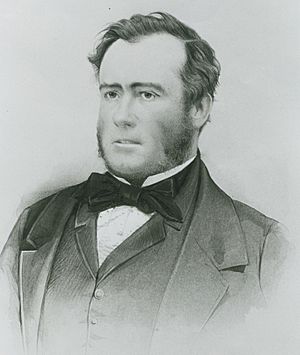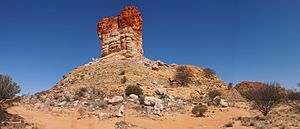James Chambers (pastoralist) facts for kids
James and John Chambers were early settlers in South Australia who left England in 1836, became wealthy pastoralists and were closely connected with John McDouall Stuart's expeditions across the continent of Australia.
James and John,and their wives Catherine and Mary (who were sisters) and their young families were among the first colonists, James arriving on the Coromandel at Holdfast Bay on 17 January 1837. The rest of the family, which included sister Priscilla Chambers, arrived off Largs Bay on 10 February 1837.
Margaret Goyder Kerr, in her book Colonial Dynasty – the Chambers family of South Australia, makes the point that the two men were physically quite different, both in build and temperament, and John wore a green satin patch over his blind right eye, so would never be confused by contemporaries. The historian however has great difficulty: they both signed their names "J. Chambers" and were involved in similar (and often the same) activities so that it is difficult if not impossible at many points to determine which brother is involved.
James Chambers
James Chambers "Jemmy" (21 September 1811 – 7 August 1862), born in Ponders End, London was a successful grazier and pastoralist in South Australia.
He was the first to drive a team of bullocks between Adelaide and Port Adelaide, and Adelaide and Glenelg, effectively creating the Port Road and Bay Road. He ran sheep on a commonage licence in the area now known as Coromandel Valley.
He bought a town acre at the first land sale, and imported horses from Van Diemens Land (he and brother John had experience as horse dealers in England). They built a house on Montefiore Hill in North Adelaide.
He opened a livery stable in North Adelaide, He bought bullocks and wagons from Cape Town and coaches from England, he tendered successfully for the mail contract to Burra around 1845 and built a substantial business carrying passengers to the mining areas north of Adelaide, including Gawler's expeditions into the country.
He sold his business to Simms & Hayter in 1853 for around £14,000 and holidayed in Long Sutton, Lincolnshire, where he had gained his horse-dealing experience. With his new-found knowledge of what was needed in South Australia, he was able to return in 1856 on the ship Albuera with a useful selection of horses, cattle and sheep.
James and his business partner William Finke found copper on one of their northern properties and on 23 July 1857 were issued with lease no 5 on some eighty acres that became known as the Oratunga Mine.nHe and Finke founded the "Great Northern Copper Mining Company" and sold eleven mines over the years.
Recognition
He largely outfitted John McDouall Stuart for four of his six northern expeditions, brother John having supplied everything for the first, and the Government providing for the sixth. This last expedition set out with great ceremony on 25 October 1861 from James's residence on Montefiore Hill, North Adelaide, where he died of complications from a carbuncle without learning of its successful outcome.
Chambers Creek and Chambers Hill (in the Adelaide Hills) were named for James Chambers. Chambers Pillar, River Chambers and Chambers Range in Central Australia as well as Chambers Bay, east of present-day Darwin, where the British flag was first raised, were named for him by Stuart. Katherine River (and hence the town Katherine) was named for his second daughter Catherine. Anna Creek, Edwards Creek and William Creek were named for John Chambers' children, by Peter Warburton in 1858, surveyor Lee in 1883, and John McDouall Stuart in 1858 respectively.



